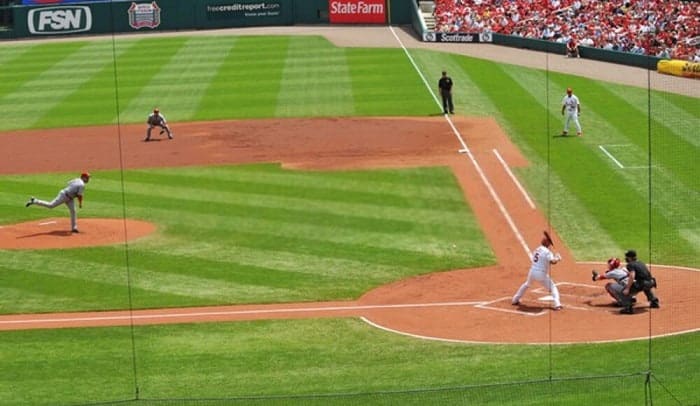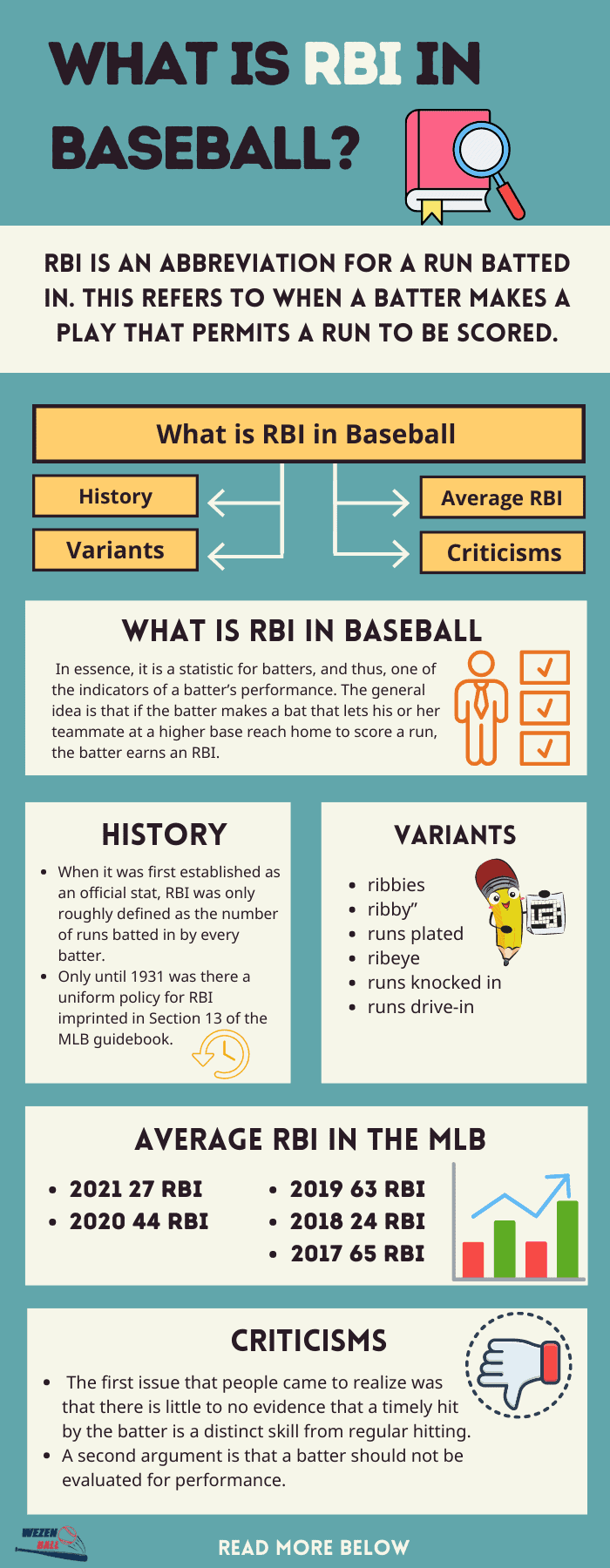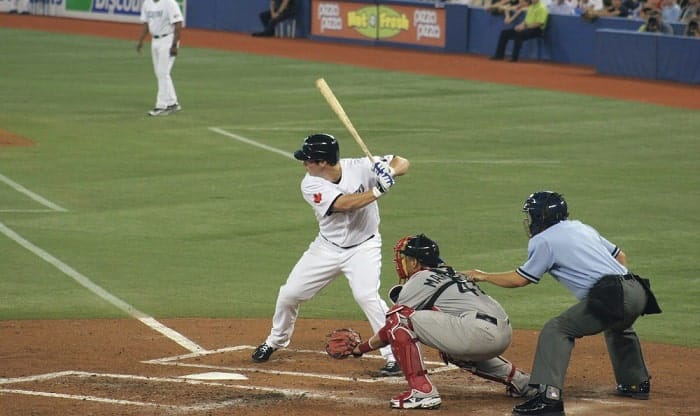Baseball is a competitive sport with a lot of technical terms, jargon, and lingo. If you are new to baseball, you should invest time and effort into learning these. It will help you make the most out of any games that you see, either in person or on TV.
A good place to start is the term RBI. So, what’s an RBI in baseball? We will answer in this detailed but succinct article. Join us!
In short, RBI is an abbreviation for run batted in. This refers to when a batter makes a play that permits a run to be scored. But, as with anything else in baseball, there is a whole lot more than you can pick up about these simple three letters. Read on to find out all about what is RBI in baseball.
Contents
What is RBI in Baseball
The RBI meaning in baseball is simple. In essence, it is a statistic for batters, and thus, one of the indicators for a batter’s performance. The general idea is that if the batter makes a bat that lets his or her teammate at a higher base reach home to score a run, the batter earns an RBI.
Aside from a hit, however, it can also be when the batter makes a sacrifice or walk. The latter is when a batter commits to an out in order for another runner to move onto the next base. This is possible through a fly ball or a bunt. The former is when a batter refrains from hitting at four pitches out of the strike zone.
If a completed run is achieved thanks to a wild pitch, passed ball, balk, fielder’s error, or home base steal, though, an RBI will not be awarded to the batter. In addition, the batter will not receive the credit of an RBI if he or she is forced into a double play or reverse double play.
The RBI as a baseball stat sits alongside home runs and batting average. In fact, it is part of the offensive Triple Crown in baseball. As such, it is one of the most popular and worth-knowing measures. If you are a seasoned batter in the realm, you will want to be known as the RBI guy.
It is easy to mix up the RBI with R, which stands for runs. It is important to remember that a run is baseball stat credited to the runner, while the RBI is for the batter. A good way to take note of this is to think of the B in RBI as a reference to the letter b in batter.
1. History
The RBI was not considered an official baseball statistic until 1920. Before that, records were kept and compiled unofficially by statisticians and writers. In particular, it was used frequently by baseball writers, like Ernie Lanigan, David Neft, and John Tattersall, from 1907 to 1919. Quite frankly, the history of the RBI is complicated. This three-letter abbreviation has gone through a tremendous evolution.
When it was first established as an official stat, RBI was only roughly defined as the number of runs batted in by every batter.
By this token, there was so much room for inconsistency through interpretation that it was near impossible for RBI records to match across sites and sources. Only until 1931 was there a uniform policy for RBI imprinted in Section 13 of the MLB guidebook.
Nevertheless, since then, it has been reinforced as a popular, official baseball statistic.
2. Variants
When you listen to live baseball commentary or watch it on TV, you may hear variations of RBI. These include “ribbies”, “ribby”, “runs plated”, “ribeye”, “runs knocked in”, and “runs drive in”. They all share the same meaning as RBI.
3. Average RBI in the MLB
For your reference, here are all the average RBI in the MLB for the last five years.
- 2021 27 RBI
- 2020 44 RBI
- 2019 63 RBI
- 2018 24 RBI
- 2017 65 RBI
This year’s player leading in MLB batting stat is Vladimir Guerrero Jr. (TOR) at 85 RBI, followed by Rafael Devers (BOS) at 82, Shohei Ohtani (AA) at 82 RBI, and Hose Abreu (CHW) AT 82 RBI. Coming in fifth Jesus Aguilar (MIA) with 76 RBI.
4. Criticisms
Even though the RBI is well-versed among seasoned baseball agents, it receives a fair share of criticisms. The first issue that people came to realize was that there is little to no evidence that a timely hit by the batter is a distinct skill from regular hitting. A lot of people claim that it is really a matter of luck. The argument revolves around the idea that hitters, in fact, do not know how to drive in runs. Instead, are blessed with making the right hit at the right time.
A second argument is that a batter should not be evaluated for performance based on how he or she performs in a run-generating situation, but instead, should be considered by other indicators that allow progress-tracking from year to year.
It is also a difficult measure for applications because not all players have an equal number of PA with runners at each base. Hence, RBI narrows down to whether you get to bat with more runners ready at second and third bases, rather than how well you bat. In such a case, is reward fair and of value?
A good batter may be able to assist a runner in moving up two bases. But, the next batter who makes the final hit for that runner to score receives the RBI. Is this right? Or is the first batter simply making the dish for the second batter to eat? Even though you registered the hit and supported the runner in advancing two bases, you lose the credit to a batter who advanced the runner only one base, but to home.
As such, it is not entirely convincing to use RBI as an indicator for a batter’s performance. There are a lot of caveats that still exist in this statistic.
RBI Baseball Leaders
Here is the wall of fame for baseball players topping the RBI records.
- David Winfield with 1,833 RBI
- Manny Ramirez with 1,831 RBI
- Al Simmons with 1,827 RBI
- Albert Pujols with 1,817 RBI
- Frank Robinson with 1,812 RBI
- David Ortiz with 1,768 RBI
- Frank Thomas with 1,704 RBI
- Reggie Jackson with 1,702 RBI
- Jim Thome with 1,699 RBI
- Cal Ripken Jr. with 1,695 RBI
Conclusion
With that, you have reached the end of this article on what is RBI in baseball. You should now be able to define RBI and be aware of other relevant information on this topic. Did you enjoy it? If yes, let us know in the comments! We are always very glad to hear from our readers, so do not hesitate! Also, if you have any follow-up questions, feel free to leave a comment. You are welcome to share this article with your family, friends, and fellow baseball fans as well.

Five years as a baseball player, my training approaches with this game give me the motivation to inspire and support young players more. Like all sports, we should start with the desire to have fun and maintain our resilience to strive better at any competition. But, of course, some of us want to have some fun and train for better health. It does not matter what your initial purpose is; I believe that most people ever holding on to the baseball bat will fall in love with the games as I do.

















